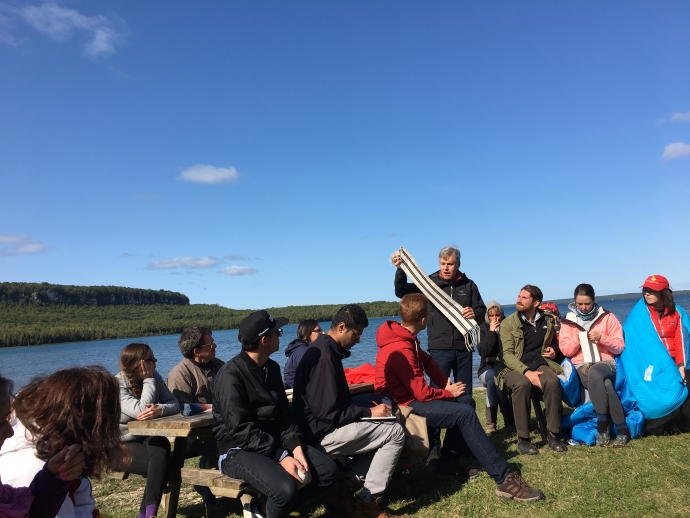By Meena Sundararaj, 2L / Photos by Amanda Carling, manager, Indigenous Initiatives Office
This September, about 30 staff and students from U of T Law went to Neyaashiinigmiing Cape Croker Reserve and learned from experts on Anishinaabe law. This was the second year of our school’s Indigenous Law in Context program.
I am not a knowledge-keeper of the teachings, so this piece will not narrate any of the stories or transmit what we learned in detail. I hope, rather, to share and reflect on some of what was imparted to us, and to encourage other students to learn about Indigenous laws.
Anishinaabe law has many sources: convention, art, family, language. We spent one afternoon briefing an Anishinaabe story that raised questions both social and personal. We each found different meanings in the story, whether we related it to conflict and/or reconciliation between European settlers and Indigenous Peoples, the teachings of family, or individual actualization. I was struck by the magnitude of meaning in the story. I considered the values it may have impressed upon people who heard it over generations, and its import at that moment in opening the perspectives of the diverse group before me.
The Anishinaabe constitution is partially concerned with constituting oneself in relation to other animate beings. Animacy is not restricted to humans or to animals: water, rocks, and our surroundings have intention, and they merit concern. Just one way of understanding this is considering that water contains the fossilized remains of creatures—there were countless imprints on the stones at Georgian Bay. Recognizing that water constitutes our bodies, the Anishinaabemowin word for water means “I am.” In the Anishinaabe legal system, water has a legal identity—not dissimilar to a Māori belief that led a New Zealand court to recognize a river as having a legal personality.
Beyond learning about the law, we also took part in ceremonial practices. Many of us participated in the optional sweat lodge, a moment to reflect and look forward.

There was an enduring sense of welcome and renewal during the trip. Our hosts shared knowledge openly. They encouraged us to add our voices and taught us the equal value of listening. We took in teachings at the edge of the bay and, in view of escarpments, helped build a ceremonial edifice for a naming ceremony, and ate and relaxed in each other’s company.
While uplifted by this rich learning experience, we were also confronted by the community’s struggles. We learned how the community is working to re-connect its youth with cultural practices. We discussed ways Indigenous nations and the Canadian government might work together to bring Indigenous legal orders and the common law into conversation, facilitate Canada’s adoption of the United Nations Declaration on the Rights of Indigenous Peoples, and further the conversation on land disputes, development, and self-governance.
I understood the Anishinaabe legal and cultural framework as fundamentally concerned with values and relationships. It emphasizes the law as internal. Values are observed not for the sake of appearance or fear of reprisal, but from understanding and experience. Our teachers imparted that this legal order has shaped and benefitted Anishinaabe communities and is integral to the nation-to-nation dialogue.
I would encourage fellow students to sign up for this opportunity for next fall, and to not be discouraged if you feel you have no prior knowledge to contribute. You will be surprised by what you have to offer, and thankful for what you bring away. I wish next year’s cohort a trip that is as educational, eye-opening, and as challenging as ours.


